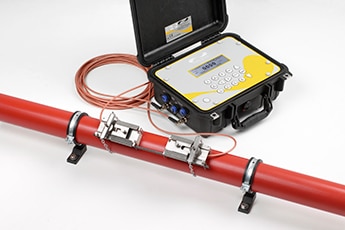Doppler Flow Meters
What is an Ultrasonic Doppler Flow Meter?

Doppler Flow Meters are ultrasonic flow meters. They measure how fast a fluid moves using the Doppler effect. This technology is used in many industries. It is common in chemical processing, water treatment, and oil and gas production. People like it because it is accurate, non-invasive, and versatile.
What is the Doppler Effect?
The Doppler effect happens when a wave, like a sound wave, bounces off moving particles or bubbles in a fluid. This fluid flows through a pipe. The movement of the particles changes the wave’s frequency. The Doppler Flow Meter detects this change and calculates the fluid’s speed.
What are the advantages of Doppler Flow Meters?
One major advantage of these Meters is that they can measure the speed of fluids with solid particles or bubbles. Unlike other flow meters, like magnetic or turbine flow meters, these can measure fluids with many particles. They do not need the fluid to be clean or conductive.
Another advantage of Doppler Flow Meters is their non-invasive nature. The ultrasonic waves from these meters go through the pipe wall and into the fluid. This means you do not need to cut the pipe or stop the fluid flow to install the meter. This can save time and money, as well as minimise the risk of leaks or contamination.
What are the types of Ultrasonic Flow Meters?
There are two types of ultrasonic flow meters: transit time and Doppler. Transit time flow meters measure the time it takes for an ultrasonic beam to travel upstream and downstream in the fluid and calculate the flow velocity based on the difference in travel time. Doppler flow meters, on the other hand, measure the frequency shift of an ultrasonic beam reflected off of moving particles or bubbles in the fluid.
Single-beam and Dual-beam Doppler Flow Meters
Doppler Flow Meters can be further classified into two types: single-beam and dual-beam. Single-beam meters use a single ultrasonic beam to measure the velocity of the fluid, while dual-beam meters use two beams, one at an angle to the other, to increase the accuracy of the measurement.
The accuracy of the meters depends on various factors, such as the size and concentration of the particles or bubbles in the fluid, the angle of the ultrasonic beam, and the speed of sound in the fluid. However, with proper calibration and installation, Doppler Flow Meters can provide highly accurate measurements of flow velocity.
History of Doppler Flow Meters
They are named after Christian Johann Doppler, an Austrian physicist who first described the principle of the Doppler effect in 1842. Since then, the technology has been refined and applied in various industries, making it one of the most widely used methods for measuring the flow of fluids.
Overall, they are a highly accurate and versatile method for measuring the velocity of fluids flowing through a pipe. Their non-invasive nature and ability to measure fluids containing solid particles or bubbles make them ideal for various industrial applications. While there are some limitations to their accuracy, with proper calibration and installation, they can provide highly precise measurements of flow velocity.